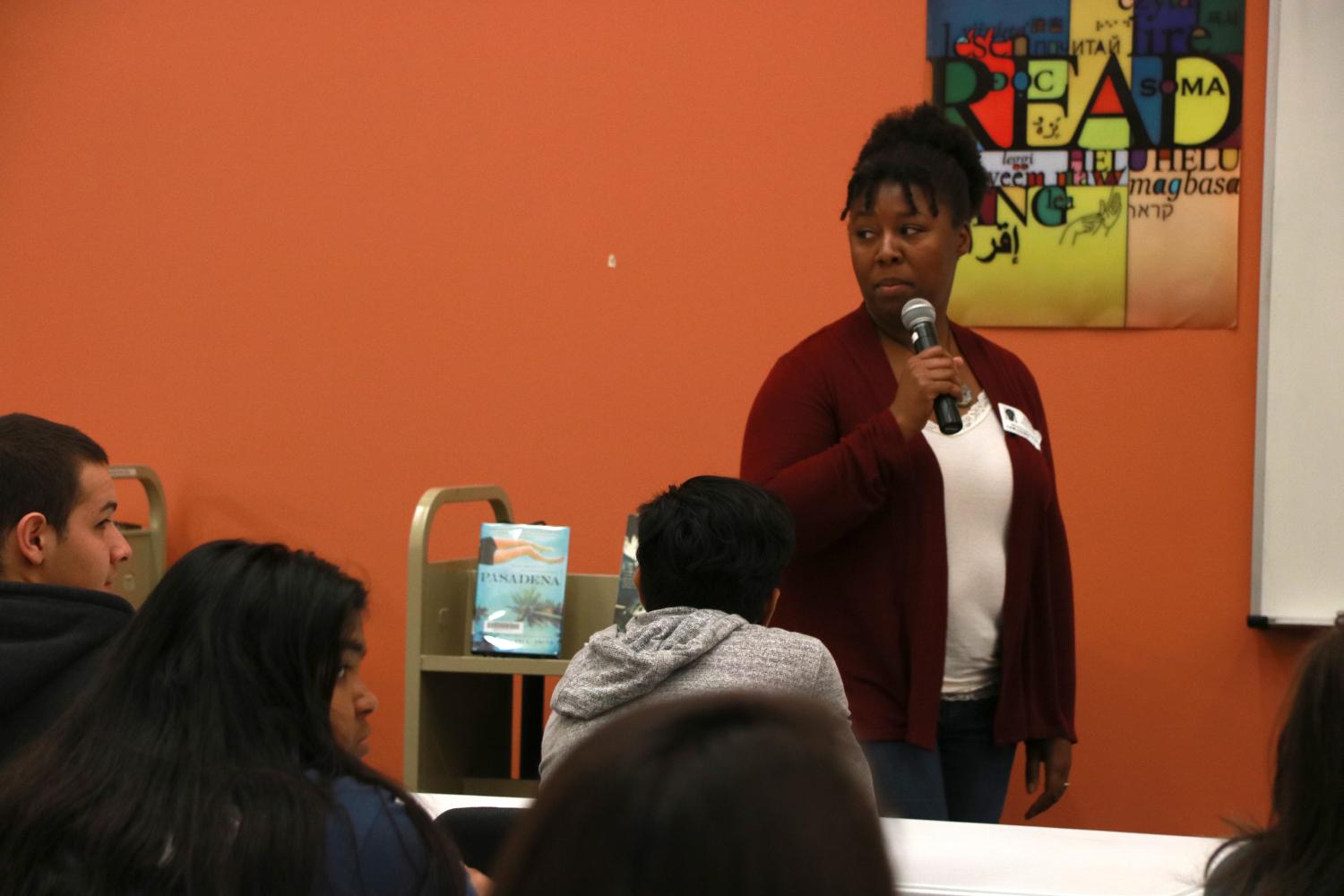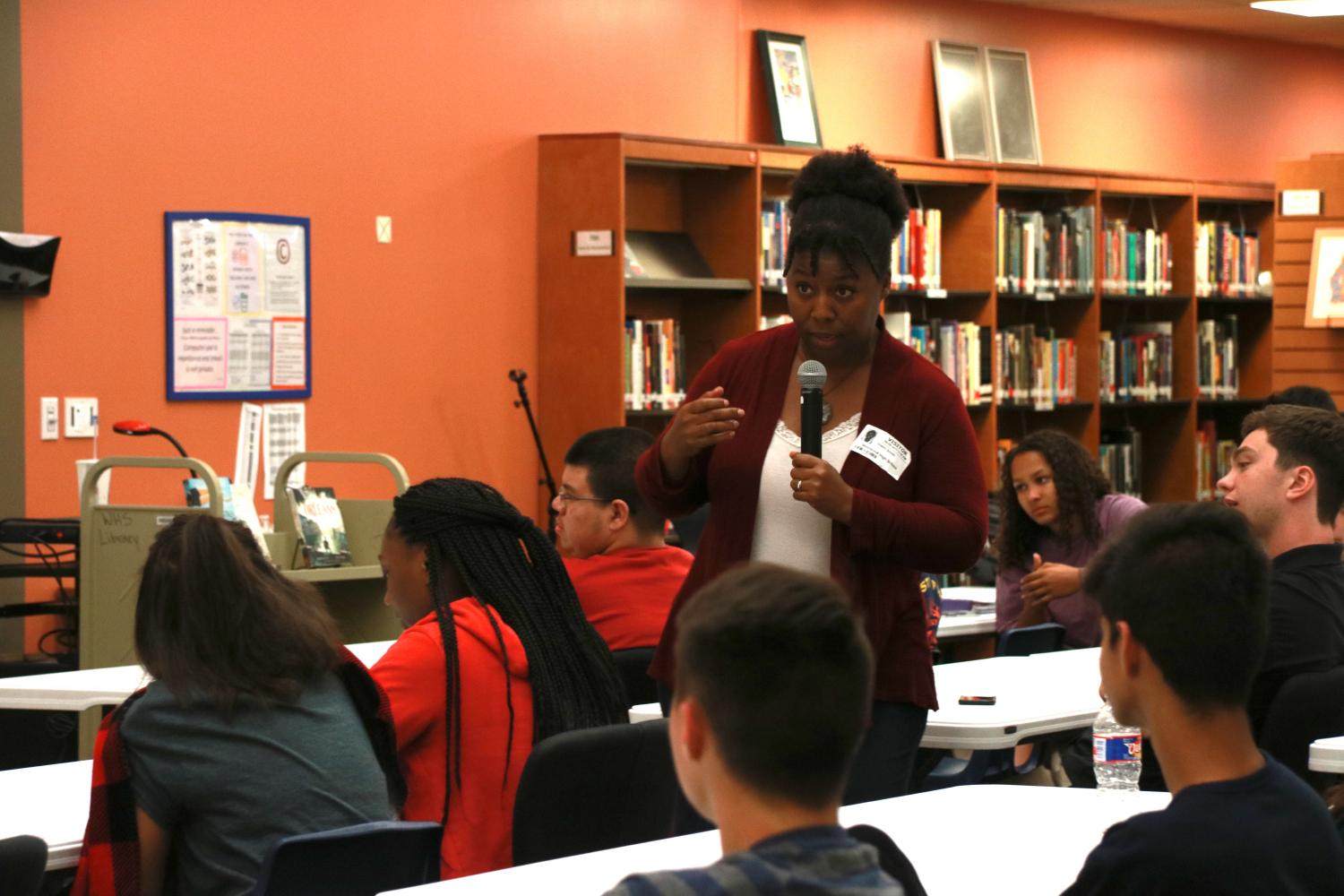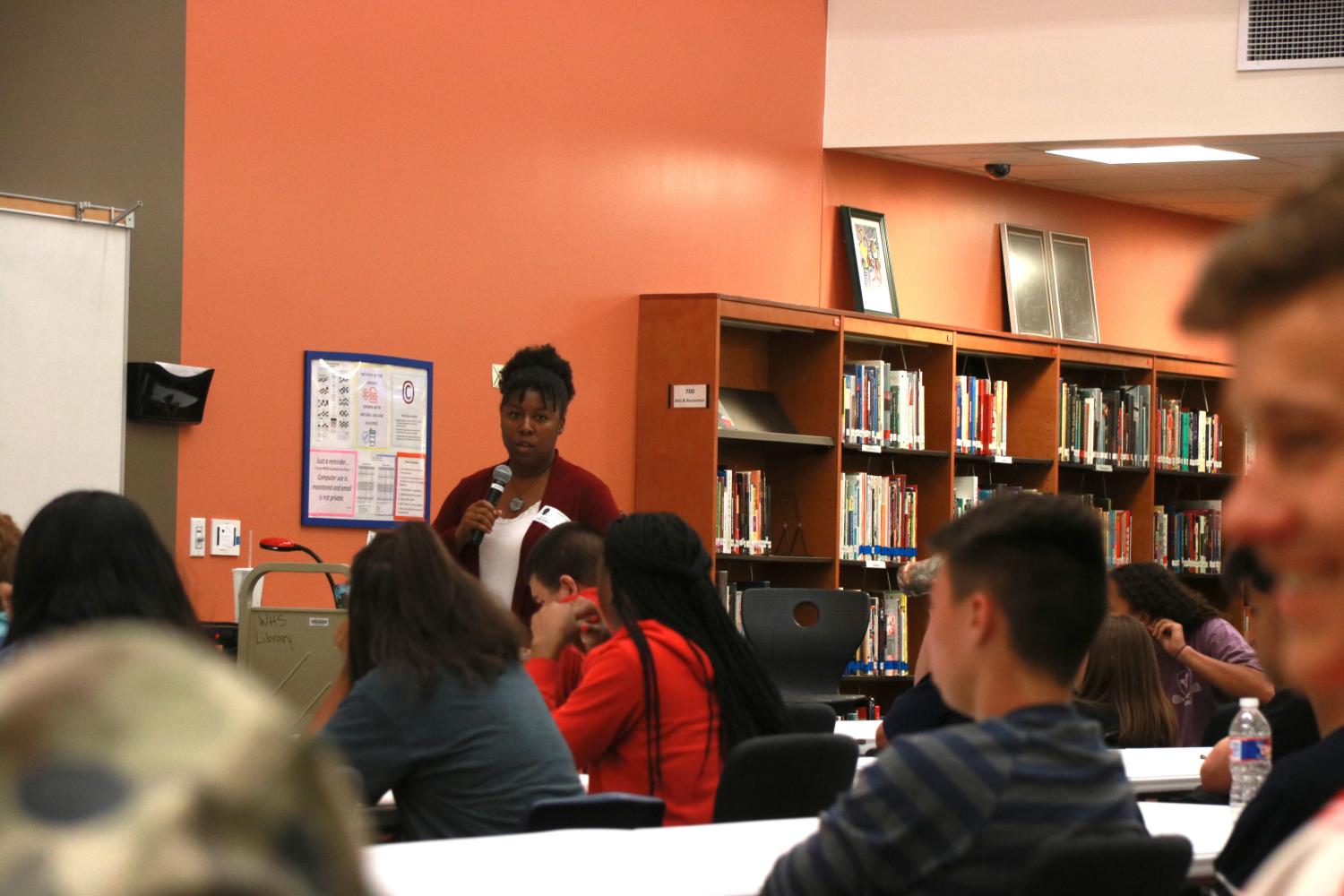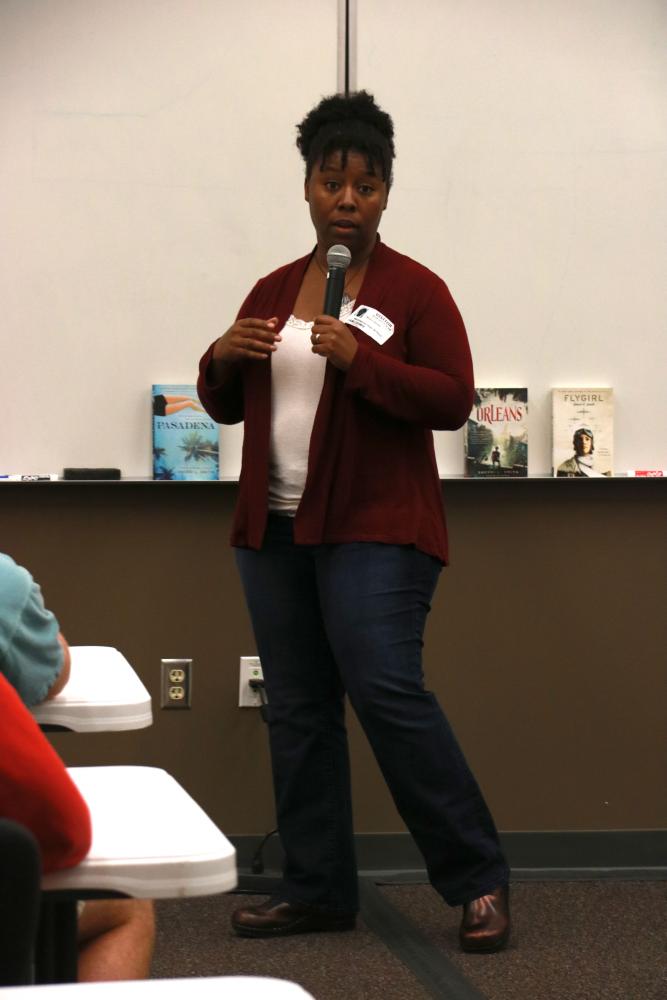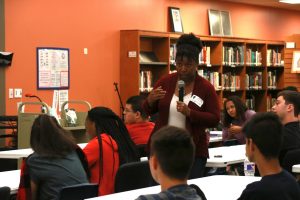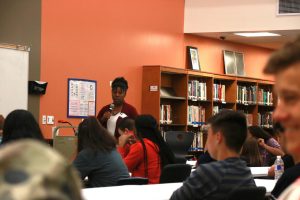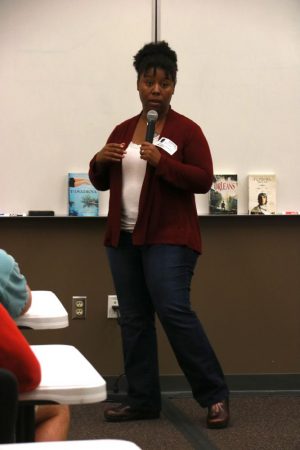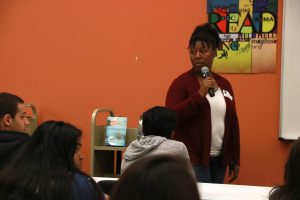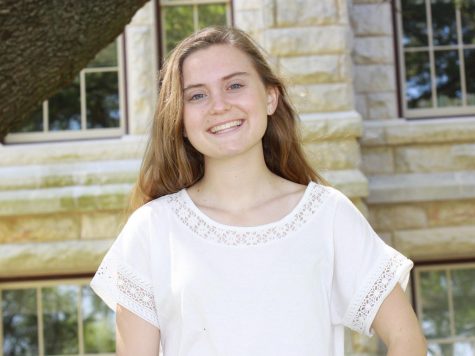Author Sherri L. Smith Encourages Students to Discover Stories
May 12, 2017
All day on May 9, classes gathered to learn about young adult author Sherri L. Smith. Throughout the meeting, Ms. Smith walked students her journey of becoming a writer, her inspiration, and her life.
Having always been surrounded the stories of family and friends growing up, Ms. Smith decided at the age of 10 that she would write a book. Unfortunately, she only got about three pages in when she realized that it wasn’t her story. In fact, she had used the plot of a book she had liked and had only changed the name of the characters.
“I was really embarrassed,” Ms. Smith said. “I was like ‘I can’t write,’ and I closed that notebook and I never wrote in it again. I still have it. But then I stopped trying to write and only wrote when teachers said I had to.”
Due to her rocky start in the literary world, Ms. Smith continued to write simply for her classes. But in her freshman year of high school, she wrote two short stories for a class that ended up in her school’s literary magazine.
“It was very exciting,” Ms. Smith said. “I saved those books. It was the first time I had something in print.”
Even though her path seemed to be intertwined with writing, Ms. Smith had never thought that she would become an author. Despite her apparent knack for literature, Ms. Smith had her sights set on becoming a doctor throughout her childhood.
“My grandmother said, ‘Oh, I thought you’d be a writer’,” Ms. Smith said. “I thought, ‘You’re the only grandmother on the planet that’s disappointed that her granddaughter wants to be a doctor.”
However, Ms. Smith’s path took on a more creative twist when she discovered her love for film. After graduating from New York University with a double major in film and journalism, Ms. Smith turned her sights to producing her own short film. Without enough funding to jump right into producing her own content, Ms. Smith took on a job in hopes of meeting the right people who could help her get started. Through this opportunity, Ms. Smith was able to work for big name studios including Tim Burton Productions and Disney TV Animation. Throughout her career at Disney, Ms. Smith worked on creating and pitching movie ideas for sequels to big Disney animated movies, such as sequels to The Lion King and Pocahontas. Despite her success in the field, Ms. Smith was unhappy that any ideas that she had while working for Disney would become the company’s property.
“I knew that I didn’t want to stay,” Ms. Smith said. “I wanted to tell my own stories but I wasn’t quite so sure what that meant. One of the screenwriters at that time lived in Alaska, and he used to invite me to come up and visit him. I thought he was just being friendly and polite, but I finally asked him if he meant it and he did.”
While the trip might have seemed like a fun way to take some time off of work, Ms. Smith discovered her first novel in Alaska.
“I went to Alaska,” Ms. Smith said. “And his friend was taking me around on a tour of Juneau. She was telling me about a school that she used to work at. It was a state run school for kids who were wards of the state, and she was telling me all of their stories. One of the kids was actually in jail. He would be bussed to school every day by the police and was returned to his cell every night. She talked about a really heavy set girl named Lucy, and she said, ‘Oh, Lucy, Lucy the Giant,’ and I heard this ‘dong’ in my head.”
What Ms. Smith didn’t know at the time was that the phrase, ‘Lucy the Giant’, was to become the title of her first published novel which pushed Ms. Smith into admitting that she was indeed, going to be an author.
“Everybody in Alaska has a really weird story,” Ms. Smith said. “They all decided to share them with me, and I was writing them all down. It was on that trip that I finally had the realization that I am a writer.”
Inspired by her trip to Alaska, Ms. Smith decided to quit her job at Disney. Just days later, she was phoned by a coworker who was leaving to support children’s authors. After teaming up, the pair published Ms. Smith’s first novel, Lucy the Giant, which had been inspired by her trip to Alaska. The novel follows a six-foot four teenager, who after running away from home, impersonates an adult to get a job on a crabbing vessel on one of the most dangerous seas in the world.
“Before I wrote a book, I used to think that not everybody could write a novel,” Ms. Smith said. “Then I wrote my first novel and thought that not everybody could write two novels. I said that all the way up until about my fifth novel.”
Much like Lucy the Giant, Ms. Smith’s fifth published novel, Orleans, also drew it’s inspiration from her life. Set in a post disaster world that has been torn apart by both natural and manmade catastrophes, a new and incurable disease emerges called Delta Fever. Fifty years after its emergence, New Orleans inhabitants are still fighting to survive by splitting into tribes organized by blood type, the last instruction they had received from the Center for Disease Control. The story follows a young girl named Fen as she struggles to save the life of a newborn baby in the midst of the surrounding chaos. The storyline came from a very similar situation that Ms. Smith’s mother faced while caught in the middle of Hurricane Katrina.
“When I saw the news [about Hurricane Katrina], I called my mom and told her that she needed to get out of there, but she said the airports were closed and the freeways were jammed,” Ms. Smith said. “My mom was 70 and diabetic, living alone. We agreed that she was to stay sheltered and in place because I had lived through hurricanes in that house before and it had always worked out.”
Luckily, Ms. Smith’s mother made it through the ordeal slightly shaken but unscathed. After trying to drive out of New Orleans, she lost her truck in flood water, had to walk two miles to a looted store to receive supplies, and narrowly avoided turning herself into the harsh conditions at the Superdome.
“I got desperate,” Ms. Smith said. “I didn’t know who to call at this point because nobody was answering their phone. So I called the coast guard. They sent an ambulance for my mom. They took her downtown where they loaded her on a bus, took her to the airport, took her off the plane and on another bus, and took her to a stadium. The Red Cross was set up there. They gave her a gift card with 300 dollars and she got in a taxi to the airport, not knowing where she was but wanting to come home to me in LA.”
After spending time in LA with Ms. Smith, her mother unfortunately passed away before renovations on her New Orleans home were finished. Ms. Smith believes that the stress of the renovation and aftermath of the storm contributed greatly to her mother’s death.
“People always tell you the body counts of disasters or what happens right then, but they never add the body count of the aftermath, the people whose hearts couldn’t take it, the people who that gap of care took them away,” Ms. Smith said. “Therefore [Orleans] is dedicated to my mom.”
Part of what makes Ms. Smith’s novels so diverse is all of the different experiences she has gone through, such as her inspiration behind Orleans and Lucy the Giant. This same trend continues to Ms. Smith’s 2008 novel, Flygirl, a historical fiction novel that was selected as one of the American Library Association’s 2010 Best Books for Young Adults, and her latest mystery, Pasadena. Aside from experimenting and trying out different genres, Ms. Smith has also explored storylines by branching away from the more traditional form of storytelling and expanding her craft to comic books, such as her latest graphic novel for James Cameron’s Avatar.
“I like to challenge myself to do different things, so I don’t write just one genre,” Ms. Smith said. “You will not see me just in science fiction or just in mystery. I like to try different things.”
Throughout Ms. Smith’s talk, she focused on one main idea that remained constant throughout the discussion and her life’s story: encouraging students to discover the stories around them.
“Everybody likes a good story, whether you think you do or not,” Ms. Smith said. “If you’re playing video games, you are part of the story. If you are watching TV or a movie, reading a book, or just chatting with your friends about what happened, that’s all storytelling.”

